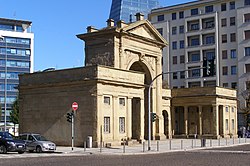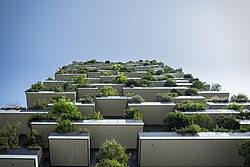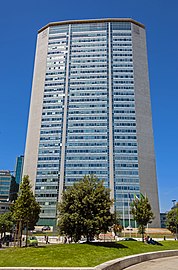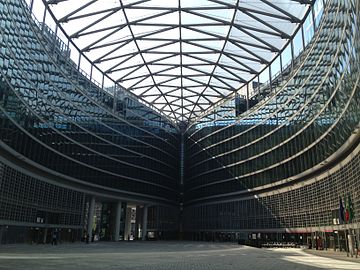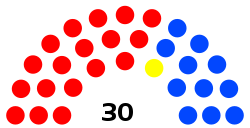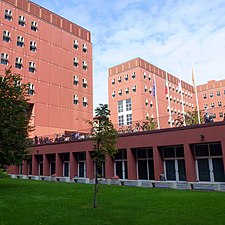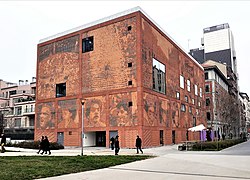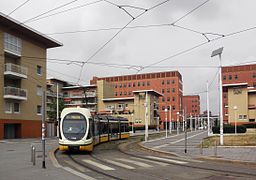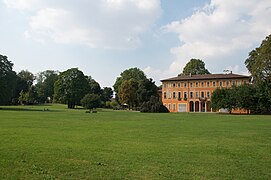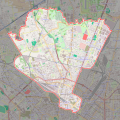
The Malpensa Express is an airport rail service linking the city of Milan with Malpensa Airport, in the region of Lombardy, Northern Italy.
The District of Milan was one of the four divisions of the Department of Olona, the province of Milan during the Napoleonic Italian Republic. It received the numeral I and its capital was Milan. Founded on May 13, 1801, it had a population of 217,807 inhabitants.
Milano Porta Garibaldi is a major railway station in the Italian city of Milan, located just to the north of the neighbourhood known as Porta Garibaldi. Porta Garibaldi is the city's main station for commuter traffic with 25 million passengers annually, although it is second to Centrale station considering total passenger traffic. The station is located on Piazza Sigmund Freud.

Quarto Oggiaro is a district of Milan in the north-west of the city. It belongs to Zone 8, and has a population of 35000 inhabitants.

The Centro Direzionale di Milano is a business district (quartiere) in Milan, Italy, part of the Zone 9 administrative division. It is located north-west of the city centre, between the major railway stations of Milano Centrale and Milano Porta Garibaldi. The district developed in the second half of the 20th century; its realization was planned by the city administration to relieve congestion in the city centre by moving business and tertiary activities in the new area. Coherently with this plan, the district is mainly occupied by modern office buildings, including several of Milan's skyscrapers.
Bicocca is a district ("quartiere") of Milan, Italy, part of the Zone 9 administrative division. It was incorporated in the city in 1841. The main historic landmark of the district is the 15th century Villa Arcimboldi. In the last decades of the 20th century, the district has been subject to a major requalification project that led to the construction of important facilities such as the University of Milan Bicocca seats and the Teatro degli Arcimboldi theatre.

Affori is a ward of Milan, Italy, part of the Zone 9 administrative division of the city, located north of the city centre. It borders with the wards of Bruzzano, Comasina, Bovisasca, Dergano and Niguarda. Before being annexed to Milan in 1923, it was an autonomous comune.
Milano Lambrate railway station is one of the main stations serving the city and comune of Milan, Italy.

Milano Greco Pirelli railway station is one of the main stations serving the comune of Milan. Opened in 1914, it is in the north of the city, in the quartiere of Greco. It is on the Milan–Monza railway.
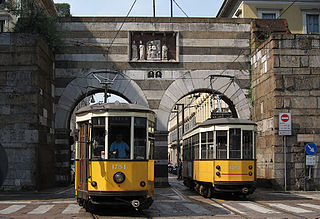
The Milan tramway network is part of the public transport network of Milan, Italy, operated by Azienda Trasporti Milanesi (ATM).

Affori Centro is a station on Line 3 of the Milan Metro which opened on March 26, 2011, twenty-one years after the opening of the original trunk of the line. It is one of the four stations on Line 3 opened to the public in 2011, forming the section from Dergano to Comasina.

Affori FN is a station on Line 3 of the Milan Metro, in Italy, which opened on March 26, 2011, twenty-one years after the opening of the original trunk of the line. It is one of the four stations on Line 3 opened to the public in 2011, forming the section between Dergano and Comasina.

The Milan S Lines constitute the commuter rail system serving the metropolitan area of Milan, Italy. The system comprises 11 lines serving 124 stations, for a total length of 403 km. There are 415 trains per day with a daily ridership of about 230,000.

The Zone 1 of Milan, since 2016 officially Municipality 1 of Milan, is one of the 9 administrative divisions of Milan, Italy.
The Garibaldi Towers are two high-rise buildings in Milan. They are next to Porta Garibaldi railway station. They were built between 1984 and 1992 by the Italian state railways Ferrovie dello Stato to house its offices. The buildings are 100 meters tall with 25 floors.
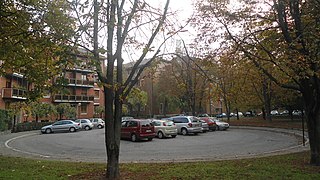
Quartiere Campo dei Fiori is a small district in Milan, Italy. The district measures 400 by 300 meters. It is located in the north-western outskirts of the city, and is a part of Zone 8.

The Milan–Asso railway is a regional railway line with standard track gauge which links Milan to Canzo crossing for Erba and other towns in Brianza. The most northern terminal is the station of Canzo-Asso, which is located in Canzo's territory but is also known as Asso in the short form. That, because there is another station on the line called Canzo station and Canzo-Asso is next to Asso's boundary and serves this commune too.

The following outline is provided as an overview of and topical guide to Milan:


